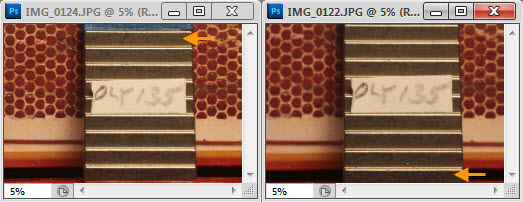To get an image that is precisely focused and framed requires simultaneously adjusting the focus setting and the subject-to-lens distance. It's annoying and time consuming.
My attention was attracted to this issue by a recent posting about "magnification pumping" (more commonly called "focus breathing"). I've never carefully investigated it before, and this seemed like a good time to start.
First, let me note that in general the change in FOV with focus depends on many aspects of lens design.
There are designs that exhibit none at all. I don't own any of those.
A couple of my point-and-shoots do come extremely close, however. For example in the following scene, my Canon A710 IS exhibits just 1% change in FOV as focus is varied across the entire range of those matchsticks.



With typical DSLR optics, the change in FOV with focus is much larger, and it's larger with some lenses than with others. So it's an interesting question what characteristics of a lens might be associated with smaller changes.
From a theoretical standpoint, there is good reason to think that lenses whose FL gets shorter as they focus closer should exhibit less change in FOV than a lens with fixed FL that focuses purely by extension. An extreme case is at 1:1, where a simple fixed-FL lens on bellows that is "focused" by front extension actually exhibits all change in FOV and no change in focus! Alternately, you can consider a variable FL "thin lens" on simple extension and ask what has to happen in order that the system exhibit no change in FOV with focus. The answer is simple: the extension stays fixed and the FL shortens by a factor of 1/(1+m) for magnification m in the plane of focus. Such a lens would shorten its FL by 50% at 1:1, whie not extending at all.
Of course, theory doesn't mean much if it's too simple to reflect reality.
So, I took a hard look at reality.
Among my DSLR macro setups, I have two adjust-by-ring lenses that go from infinity focus to 1:1. One of those is a Canon 100mm f/2.8L IS USM with internal focusing; the other is a Sigma 105mm f/2.8 EX with front focusing. Both of them exhibit roughly 30% FL shortening at closest focus, with the front focusing lens actually shortening a bit more.
I also have a couple of Olympus bellows macro lenses that are suitable for use in this magnification range: the 135mm f/4.5 and the 80mm f/4.
The test I ran was to set up all these lenses to shoot a subject around magnification 0.7:1, then measure the change in FOV for a fixed change in focal depth.
Here is a picture of the test subject and focus points (orange arrows). It's a step block, 21.7 mm from base to the step with blue tape above it (versus 14.9 mm sensor height); the delta focus is 11 mm.

Here is a typical pair of images, from the Olympus 135. You can see from the blue tape and the base of the block that there is significant change in FOV with this lens.

Measuring the images, here are the results:
Sigma 105: FOV change = 5.1%, WD (in front of lens) ~ 165mm
Canon 100: FOV change = 5.1%, WD (in front of lens) ~ 165mm
Oly 135: FOV change = 6.8%, WD (in front of lens) ~ 295mm
Oly 80: FOV change = 13.3%, WD (in front of lens) ~ 160mm
In these data I note the following:
a) The two adjust-by-ring and FL-reducing lenses have virtually identical values for scale change and working distance, despite that one of them is front-focusing and the other is internal.
b) Both of the FL-reducing lenses have significantly less change in FOV than the fixed FL lenses do (when focused by changing front extension).
Is there anything useful here?
Well, from my standpoint it's certainly reassuring to see that my Canon 100mm f/2.8L IS USM shows the smallest change in FOV with focus. That lens is also very sharp, and it has an entrance pupil that moves very little if at all with changing focus, so it's great for stacking under AF motor control.
It's also reassuring to see that these lenses are consistent with the predictions of simple theory.
Other people have reported different results with their lenses, however, so perhaps the most important conclusion is the ever popular one:
I hope this is helpful.You have to test your own equipment. Other people's tests of their equipment quite possibly do not apply to yours.
--Rik
Edit: to add the more commonly used term "focus breathing".
